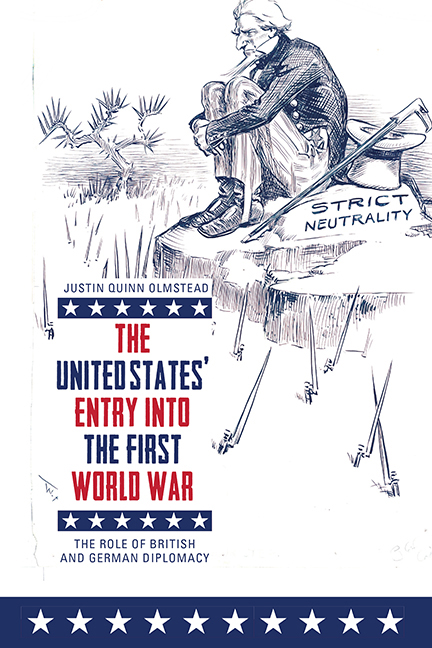Book contents
3 - The Diplomacy of U-Boat Warfare
Published online by Cambridge University Press: 12 October 2019
Summary
By November 1914, merely three months into the war, it was clear that Germany was unable to win by military might alone; the military situation had begun to dictate diplomacy. In addition to setbacks on land, the German military was facing stumbling blocks due to British naval policy. Under these circumstances, the German military broached the possibility of submarine warfare.
It is an unfortunate reality that the debate about German-American relations during the war is generally framed around how the United States reacted to the idea of submarine warfare, the sinking of neutral merchant ships, and the deaths of American citizens due to submarine attacks on all ships. What has not been placed under the microscope is how the German decision to utilize the submarine drove both the diplomatic response of the US toward the belligerents, and Great Britain's policy toward the United States. To that point, Wilson's ‘strict accountability’ policy is generally confused as a threat of war.
In 1934 Charles Seymour argued that ‘strict accountability’ had meant that, if German submarine attacks continued, US entry into the war was unavoidable. This idea that Germany's unrestricted submarine warfare drove the United States to enter the war against Germany does not account for the almost three full years of submarine activity, along with other issues between the United States and Germany, before President Wilson asked Congress for (and received) a declaration of war against Germany.3 There is no argument that the resumption of unrestricted submarine warfare in 1917 was a key factor in Wilson's decision to enter the war, but a greater understanding of the ‘strict accountability’ policy will lead to a better comprehension of the German-American diplomacy of the period. It is also important to understand how central submarine warfare was to German policy toward the United States, including Bethmann's 1916 peace démarche.
The Chancellor's Challenge
Analysis of German activity in the United States must be tempered by the knowledge that, early in the war (from August to October 1914), most of Germany's leaders – both military and political – were very optimistic that victory would come relatively soon. Germany's plan of attack, the Schlieffen Plan, called for the war in the west to be over in about six weeks, in order to focus on fighting Russia in the hope of forcing that country to sue for peace.
- Type
- Chapter
- Information
- The United States' Entry into the First World WarThe Role of British and German Diplomacy, pp. 66 - 101Publisher: Boydell & BrewerPrint publication year: 2018

